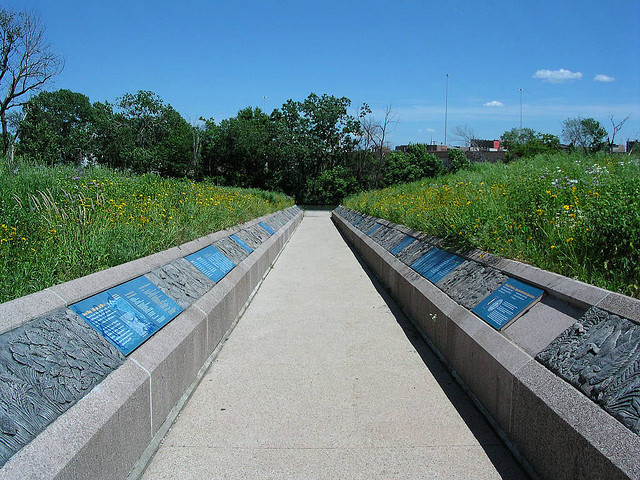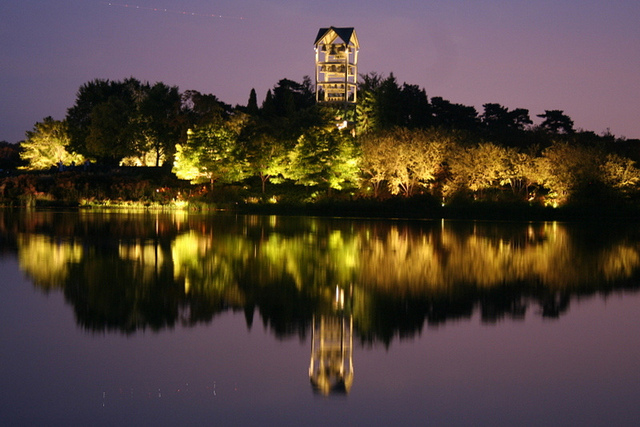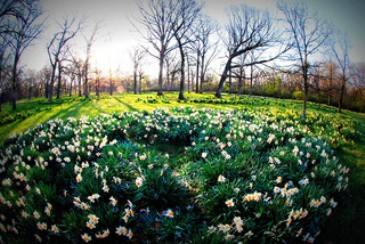Chicagoist's 13 Best Places To Enjoy The Outdoors
By Staff in Arts & Entertainment on Apr 10, 2013 4:00PM
When the seasons change and it gets warm, Chicago seizes the outdoors and strangles the life out of it. Befitting a city born from a prairie, here are some of out favorite places to enjoy the outdoors. They may be rooted in nature, they may not. But it's our list and we're sticking with it. Leave your favorites in the comments.
Canal Origins Park has a lovely view of part of the Loop through the eye of the Chicago River and is out of the way, so the only folks you run into are usually random fishers. The pathway at the mouth of the Sanitary and Ship Canal has a nice history of the canal etched into it, and after you cross Ashland to the walk along the canal, it's quite green and comfortable. It's a great place to watch the barges go by. — Aaron Cynic
Canal Origins Park is located at 2840 S. Ashland Avenue
Chicago’s industrial southland is also home to its greatest biodiversity. Eggers Woods, Kickapoo Woods, Beaubien Woods and Wolf Lake are among the southeast side gems that now anchor the Millennium Reserve region. The wetlands and prairies currently in resurgence thanks to local conservationists are as much a part of Chicago’s identity as Carl Sandburg’s steel and industrial grit, and nowhere are both more connected than in the Calumet region. — Chris Bentley

In a few years, the Bloomingdale Trail will rival New York City's High Line. (Photo credit: Colin Clinard)
The Henry C. Palmisano Nature Park (aka "Mount Bridgeport") is a fascinating experiment in urban planning. Originally a limestone quarry that operated until 1970, it later became a destination for clean construction waste until the city closed it in 1999. In 2004 the city approved a Park District plan to transform it into a nature park and the results are stunning. Over 40,000 square feet of topsoil was trucked in to cover the debris and sculpted into a 33-foot high hill surrounded by 1.7 miles of catwalks and walkways; the top of the hill provides one of the most unique views of the downtown skyline, with the Stevenson Expressway in the foreground. At the northwest corner of the park the limestone walls serve as a backdrop for a retention pond stocked with goldfish, bluegill, large mouth bass and green sunfish, the pond is fed by rain and ground water via an underground piping system isolated from the rest of the neighborhood's storm drain system. The water from the pond is pumped to the northeast corner of the park and cascades back to the retention pond, providing aeration. Vegetation for the cascading system was chosen for its nativity to the area and for their ability to filter out urban pollutants. The deepest area of the retention pond is 14 feet and the elevator shafts that hauled miners down to the quarry were left untouched, to give the park a sense of history. — Chuck Sudo and Aaron Cynic
Henry C. Palmisano Nature Park is located at 2700 S. Halsted St.

At Henry C. Palmisano Nature Park you can view the dolomatic limestone above the fish-stocked retention pond. (Photo credit: Chuck Sudo/Chicagoist)
I love Belmont Harbor because I like the nautical life or at least the voyeurism of seeing other people's boats catch the wind in their sails. On balmy Saturday mornings you can usually spy some privileged children shakily steering some pygmy vessels out onto the lake, which is pretty cute. The park area surrounding the harbor often serves as space for outdoor movies, performances by the likes of Redmoon Theater, and my own errant kite flying. There's also a dog beach nearby, making it worthwhile to pack a picnic and stay the afternoon. — Melissa Wiley
Belmont Harbor is located at 3600 Recreation Drive.
Moving to Chicago from St. Louis, I thought I'd be spoiled in one area: local zoos. St. Louis' zoo is huge, beautiful and free. Luckily, so is Lincoln Park Zoo. It may not be as expansive as Brookfield, but if you're looking to spend a cheap afternoon in the outdoors, Lincoln Park Zoo is the way to go. Its accessibility is also something to be noted. Dip off from your Clark Street shopping trip and you’re only a short walk away. If you need even more reason to plan a trip, look at this new bushbaby that just arrived. I dare you to resist that face. — Katie Karpowicz
Lincoln Park Zoo is located at 2001 N. Clark Street.

Pritzker Pavilion is packed during the summer with concerts and concertgoers. (Photo credit: Vbajda)
The Museum of Contemporary Art is located at 220 E. Chicago Ave. Millennium Park is located at 201 E. Randolph St., between Michigan Avenue and Columbus Drive.
The railroad retaining walls in LaBagh Woods are plastered with loud graffiti, but they lead down to the serene banks of the Chicago River. Bound by Bryn Mawr and Foster avenues, as well as Montrose Cemetery to the east, it’s a small forest that leaves a big impression. Though the Edens Expressway runs along Labagh’s western edge, its trail feels miles away from the city. Deer, great blue heron and warblers are common sights. — Chris Bentley
LaBagh Woods is located at Cicero and Foster Avenues.
It's a bit of a haul from the city to the Chicago Botanic Gardens but the destination is worth the travel. Every square inch of its 385 acres is put to excellent use with four natural habitats, 26 gardens, 81 acres of water, six miles of shoreline, nine islands and one of the most acclaimed collections of Bonsai in the United States. With 50,000 members, the Chicago Botanic Garden boasts the largest membership of any botanic garden in the nation. It’s free to visit, but you have to pay $25 to park if you aren’t a member so we recommend biking the 25 miles of the North Branch Trail from Caldwell Woods (just north of LaBagh Woods) all the way to the Garden’s southern edge. Along the way you’ll enjoy the wonders of the Forest Preserve District, including the tranquil Skokie lagoons. — Chuck Sudo
The Chicago Botanic Garden is located at 1000 Lake Cook Road in Glencoe.
There is something sort of surreal to pull off a highway, drive a short distance, and enter an oasis of utter peace and solitude. The Morton Arboretum is just a 25 mile drive from Chicago. A walk around the 16 miles of paths and 1,700 acres that make up the preserve makes you realize how nice it is to not have the city noise (and traffic) for just a few hours. Along with the paths, there is a nice visitor center, children's area, and a great open area for concerts (the Chicago Symphony Orchestra plays June 27, 29, and 30). Sadly, this oasis is only open until 6 p.m. during the summer so you will have to return to the city eventually. It's nice to know, however, that peace isn't too far away. — Paul Leddy
The Morton Arboretum is located at 4100 Illinois Route 53 in Lisle.
During baseball season I get a rush up my spine whenever I hear the sound of fireworks from Sox Park whenever a White Sox player hits a home run. Being able to hear those explosions in the distance while watching the sun make its descent in the west from a back porch is one of those indelible summer memories I can only hope to express to my nephews and nieces with the same excitement it gives me. Add to that feeling the smell of some meats in a smoker, a cooler full of beer and some idle conversation with the neighbors and you have a quintessential Chicago experience. You can also enjoy it on the North side but, trust me, the roar of White Sox fireworks makes the experience better. — Chuck Sudo
Few things are as perfect an encapsulation of Chicago as a cold beer on your front stoop in the middle of another muggy Chicago summer, watching the sun paint beautiful portraits on the western horizon, cars slowly make their way down the street blasting bass from a subwoofer in the trunk, while the ice cream trucks sing their irresistible Siren songs to impressionable children cooling off near an open fire hydrant. We even head to the ice cream trucks for a banana split or a Boston shake to go with the beer. — Chuck Sudo
Front stoops are located wherever three-flat apartment buildings can be found.



